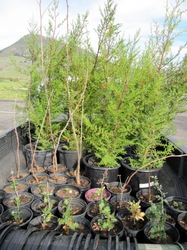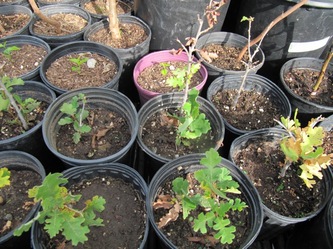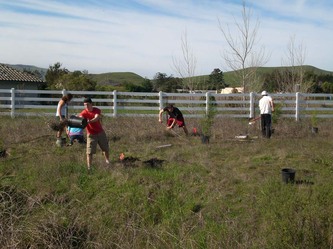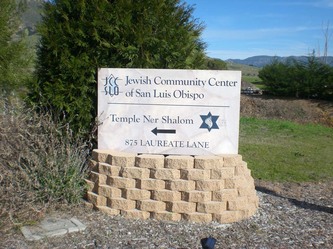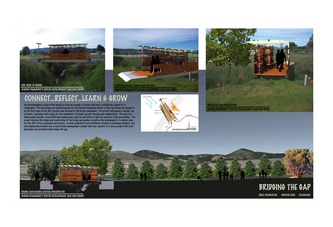B'Echad
JCCSLO Bridge and Community Spiritual Garden
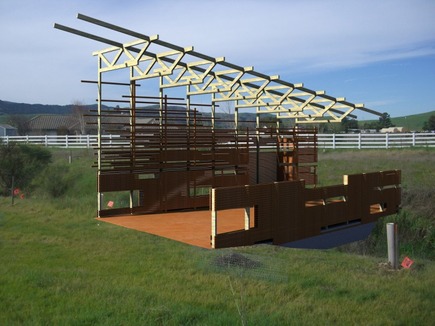
Current rendering of Bridge to Community Spiritual Garden
JCCSLO has proposed the design and construction of a bridge and garden as part of their campus at 875 Laureate Lane. The bridge, when constructed, will span a 25 foot wide seasonal creek, giving JCCSLO new access to a corner of their site. This corner is to be transformed into a community garden, based on the concepts and values of Judaism and sustainability. The garden is meant to welcome their neighbors onto the site, with the intention of fostering interaction and growth between the Laureate Lane community and the public at large.
The focus of the project is to create interaction and harbor discussion. With this in mind, the bridge itself becomes an experience, setting the tone and creating a transition between the garden and the outside world. Designed and constructed in a multi-disciplinary environment, the project should become a symbol of community strength and the power of collaboration. The Cal Poly team working on the bridge and garden project is comprised of students from Architectural Engineering, Civil Engineering, and Landscape Architecture departments. The structure and garden are to be designed and constructed as a collaborative design-build project. Essentially, the goal is to bridge the gap, not only among student disciplines, but also physically and symbolically within our community.
The focus of the project is to create interaction and harbor discussion. With this in mind, the bridge itself becomes an experience, setting the tone and creating a transition between the garden and the outside world. Designed and constructed in a multi-disciplinary environment, the project should become a symbol of community strength and the power of collaboration. The Cal Poly team working on the bridge and garden project is comprised of students from Architectural Engineering, Civil Engineering, and Landscape Architecture departments. The structure and garden are to be designed and constructed as a collaborative design-build project. Essentially, the goal is to bridge the gap, not only among student disciplines, but also physically and symbolically within our community.
Project Goals: Connect, Reflect, Learn and Grow
Connect: Create connections between people and spaces
In addition to providing a physical connection and access to an otherwise inaccessible part of the site, the bridge will offer a means by which to connect the three sides of the Laureate Lane neighborhood (synagogue, school, church) in one community space. The bridge allows the transition into a new area of acceptance and communication, encouraging people to learn about each other and celebrate their differences. Playing off common religious threads, the garden and bridge will invite all believers and non-believers alike, in hopes of sparking intellectual and spiritual conversation. The physical connection of the bridge becomes a metaphor for the deeper connection and goal of the project. Crossing should become an experience in itself and should help the user to see something new in the nature and life around them. Nature should become inspiration as the user connects not only to those around them, but to their natural surroundings as well. The garden space is meant to house spaces for bringing people together. Part of the program is gathering spaces that are multi-functional enough to be used as outdoor classrooms, wedding reception areas, and anything in between. Within this space, one should be able to sit quietly and think, have a discussion with friends or learn about growth, nature and sustainability through experiencing the garden. The deeper goal is to make a connection back to nature to help us rediscover ourselves.
Reflect: Self-reflection is an important part of any spiritual or psychological growth
In Plato’s Apology, Socrates said that the unexamined life is not worth living. In order to find meaning and reaffirm our beliefs, they must first be questioned and considered. This is part of the process of finding ourselves and realizing what is important to us. As a spiritual garden, this new space on Laureate Lane will attempt to provide the sort of environment that not only allows for this sort of dialogue, whether it be internal or external, but fosters it.
The garden should be a place where world-views and beliefs can be discussed freely and openly, while still providing small pockets of space for personal reflection. Using nature and its beauty, the garden should inspire thought and reflection on life. Views of the untamed and beautiful landscape that surrounds the sight should be allowed to be the focus, encouraging the user to be inspired to meditate in the sights, smells and sounds of nature.
Learn and Grow: The bridge and garden become spaces for learning
We learn about each other, ourselves, different values and cultures, and nature. Everyone becomes both student and teacher in these spaces, both gaining and distributing knowledge simultaneously. People learn best from one another. With this in mind, the potential uses for the garden can encourage our community leaders to educate others through example. The experience itself should be educational and nature can be used as a mentor. By showcasing its brilliance, we can learn first-hand about becomming good stewards of the environment and the efficient use of resources. Elementary students can use the garden to learn about cycles and natural processes. The bridge itself can become a part of the educational environment by exposing its structure, and allowing the users to gain an understanding of the physical world through structure and form. Even the construction process will be educational, both to the team members and the elementary students who have volunteered to help with the construction. The lesson will tie in nicely and add a “learn-by-doing” aspect to the fourth grader’s study of bridges. There is so much potential to learn and develop within the programs of these new spaces. The users will have the opportunity to get to know their neighbors, learn about different cultures and beliefs, while also gaining insight into nature and its systems and solutions.
In addition to providing a physical connection and access to an otherwise inaccessible part of the site, the bridge will offer a means by which to connect the three sides of the Laureate Lane neighborhood (synagogue, school, church) in one community space. The bridge allows the transition into a new area of acceptance and communication, encouraging people to learn about each other and celebrate their differences. Playing off common religious threads, the garden and bridge will invite all believers and non-believers alike, in hopes of sparking intellectual and spiritual conversation. The physical connection of the bridge becomes a metaphor for the deeper connection and goal of the project. Crossing should become an experience in itself and should help the user to see something new in the nature and life around them. Nature should become inspiration as the user connects not only to those around them, but to their natural surroundings as well. The garden space is meant to house spaces for bringing people together. Part of the program is gathering spaces that are multi-functional enough to be used as outdoor classrooms, wedding reception areas, and anything in between. Within this space, one should be able to sit quietly and think, have a discussion with friends or learn about growth, nature and sustainability through experiencing the garden. The deeper goal is to make a connection back to nature to help us rediscover ourselves.
Reflect: Self-reflection is an important part of any spiritual or psychological growth
In Plato’s Apology, Socrates said that the unexamined life is not worth living. In order to find meaning and reaffirm our beliefs, they must first be questioned and considered. This is part of the process of finding ourselves and realizing what is important to us. As a spiritual garden, this new space on Laureate Lane will attempt to provide the sort of environment that not only allows for this sort of dialogue, whether it be internal or external, but fosters it.
The garden should be a place where world-views and beliefs can be discussed freely and openly, while still providing small pockets of space for personal reflection. Using nature and its beauty, the garden should inspire thought and reflection on life. Views of the untamed and beautiful landscape that surrounds the sight should be allowed to be the focus, encouraging the user to be inspired to meditate in the sights, smells and sounds of nature.
Learn and Grow: The bridge and garden become spaces for learning
We learn about each other, ourselves, different values and cultures, and nature. Everyone becomes both student and teacher in these spaces, both gaining and distributing knowledge simultaneously. People learn best from one another. With this in mind, the potential uses for the garden can encourage our community leaders to educate others through example. The experience itself should be educational and nature can be used as a mentor. By showcasing its brilliance, we can learn first-hand about becomming good stewards of the environment and the efficient use of resources. Elementary students can use the garden to learn about cycles and natural processes. The bridge itself can become a part of the educational environment by exposing its structure, and allowing the users to gain an understanding of the physical world through structure and form. Even the construction process will be educational, both to the team members and the elementary students who have volunteered to help with the construction. The lesson will tie in nicely and add a “learn-by-doing” aspect to the fourth grader’s study of bridges. There is so much potential to learn and develop within the programs of these new spaces. The users will have the opportunity to get to know their neighbors, learn about different cultures and beliefs, while also gaining insight into nature and its systems and solutions.
Can you help us with this project?
Financial or physical contributions are needed.
The construction costs for the bridge and garden will reach roughly $10,000. To donate, please click on the "Donate" button or send a check payable to JCCSLO, 875 Laureate Lane, San Luis Obispo, 93405. Please include the memo that the donation is for the Bridge and Garden project. Donations are tax-deductible (Federal Tax ID, JCC of SLO County, #77-0457417).
The construction costs for the bridge and garden will reach roughly $10,000. To donate, please click on the "Donate" button or send a check payable to JCCSLO, 875 Laureate Lane, San Luis Obispo, 93405. Please include the memo that the donation is for the Bridge and Garden project. Donations are tax-deductible (Federal Tax ID, JCC of SLO County, #77-0457417).
Once we secure funds to begin construction, we will need manpower! To volunteer working on the bridge or garden, please click here.
“life is a garden, not a road we enter and exit through the same gate wandering, where we go matters less than what we notice”
-Bokonon, The Lost Book
-Bokonon, The Lost Book

